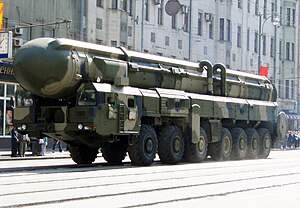| RT-2PM Topol SS-25 Sickle | |
|---|---|
 | |
| Type | Intercontinental ballistic missile |
| Place of origin | Soviet Union |
| Service history | |
| In service | 1985–2023 |
| Used by | Russian Strategic Missile Troops |
| Production history | |
| Designer | Alexander Nadiradze[1](Moscow Institute of Thermal Technology), continued after his death by Boris N. Lapygin. |
| Manufacturer | Votkinsk Machine Building Plant |
| Produced | 1985 |
| Specifications | |
| Mass | 50,100 kg (110,500 lb) |
| Length | 23.5 m (77 ft) |
| Diameter | 2.17 m (7 ft 1 in) |
| Warhead | 1 x 800 kt or 1 x 1 Mt |
| Engine | Three-stage Solid-fuel rocket |
Operational range | 11,000 km (6,800 mi) |
| Maximum speed | approx. 7.4 kilometres per second (27,000 km/h; 17,000 mph; Mach 22) |
Guidance system | Inertial, autonomous |
| Accuracy | 200-900m[2] m CEP |
Launch platform | Road-mobile TEL |

The RT-2PM Topol[3] (Russian: РТ-2ПМ Тополь ("Poplar"); NATO reporting name SS-25 Sickle; GRAU designation: 15Ж58 ("15Zh58"); START I designation: RS-12M Topol)[4] was a mobile intercontinental ballistic missile designed in the Soviet Union and in service with Russia's Strategic Missile Troops. As of 2014[update], Russia planned to replace all RT-2PM ICBMs with versions of Topol-M.[5] In December 2023, the last Topol regiment was taken off combat duty.[6]
- ^ "Topol". Archived from the original on 30 October 2013. Retrieved 23 December 2014.
- ^ "RT-2PM Topol (SS-25)".
- ^ "Russia Fires Topol Ballistic Missile to Test New Tech to Defeat Missile Defense Systems". 26 December 2017.
- ^ "RS-12M Topol (SS-25 'Sickle'/RT-2PM)", Jane's Strategic Weapon Systems, 2008-09-10, archived from the original on 2013-01-03
- ^ "Russian ICBM Force Modernization: Arms Control Please!". fas.org. 2014-05-01.
- ^ Cite error: The named reference
:0was invoked but never defined (see the help page).